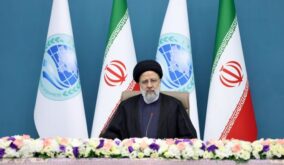Radiofarda – Iran’s Energy Minister Reza Ardakanian says widespread blackouts would be inevitable as the country experiences its driest year in five decades.
Ardakanian also cautioned that 334 cities with their nearly 35 million population are going to grapple with “water crisis” next summer.
The volume of water flowing into Iran’s damns is 43 percent lower than usual, leading to a 61 percent drop in energy produced at hydroelectric power stations, Iran’s Energy Ministry has reported.
With the country in the midst of its worst drought in decades, Energy Minister Reza Ardakanian warned April 8 that power outages will sweep the country this summer.
“Since the volume of water behind the dams is significantly lower than usual, if residents do not decrease electricity consumption, power cuts will be inevitable across the country,” Ardakanian said.
Decreased precipitation has led to depleted reservoirs at 177 dams throughout the country, at the Caspian Sea, the Persian Gulf, Lake Urmia, the Central Plateau, Hamoun, and Sarakhs. The total volume of water in the reservoirs is estimated at 24.5 billion cubic meters, which is 24 percent less than last year. Only half of the dams have the reliable inflow of water needed to maintain hydroelectric power production at current levels.
As an example of the challenge facing Iran’s hydroelectric plants, Ardkanian singled out the Zayandeh Rood dam in Central Iran. Built in 1967 under Shah Mohammad Reza Pahlavi, the dam was originally named the Shah Abbas dam after a legendary king.
“It has never experienced such a lack of water since its inauguration,” Ardakanian said.
Ardakanian had earlier cautioned that 334 cities with their nearly 35 million population are going to grapple with a “water crisis” this summer, and that the energy output from Iran’s hydroelectric power stations will by 4,300 MW lower than last year, leading to frequent power outages this summer.
The Energy Ministry’s latest report shows that the volume of water in the reservoirs of five dams: Amir Kabir, Lar, Latyan, Taleqan, and Mamloo, in province of Tehran, is 648 million cubic meters, or 36 percent of their capacities.
Meanwhile, Deputy Energy Minister Hedayat Fahmi has warned that the water crisis may lead to protests and unrest in urban areas, turning neighboring provinces against each other as they fight over drastically limited resources.
Describing water shortages as a matter more crucial than the Joint Comprehensive Plan of Action (JCPOA), Tehran’s nuclear deal with world powers, Fahmi cautioned, “If a dispute over the quality of water breaks out, people of different provinces in Iran will face each other as hostile foreign forces,” adding, “This is an internal danger threatening the country.”
American research organization Water Politics has reported that Iran faces the danger of “water insecurity.” The Islamic Revolutionary Guards Corps (IRGC) has been involved in building around 600 dams across the country in recent years, and according to a Water Politics report, the aggressive dam building has done more to exacerbate the water shortage than alleviate it.
Iran has been experiencing long cycles of drought for the last fifty years, with the average amount of precipitation per decade dropping from 250 to 217 millimeters during that time. Though there is a historic downward trend in precipitation, Ardakanian emphasized that this year will be the driest ever on the books.
 Shabtabnews In this dark night, I have lost my way – Arise from a corner, oh you the star of guidance.
Shabtabnews In this dark night, I have lost my way – Arise from a corner, oh you the star of guidance.


